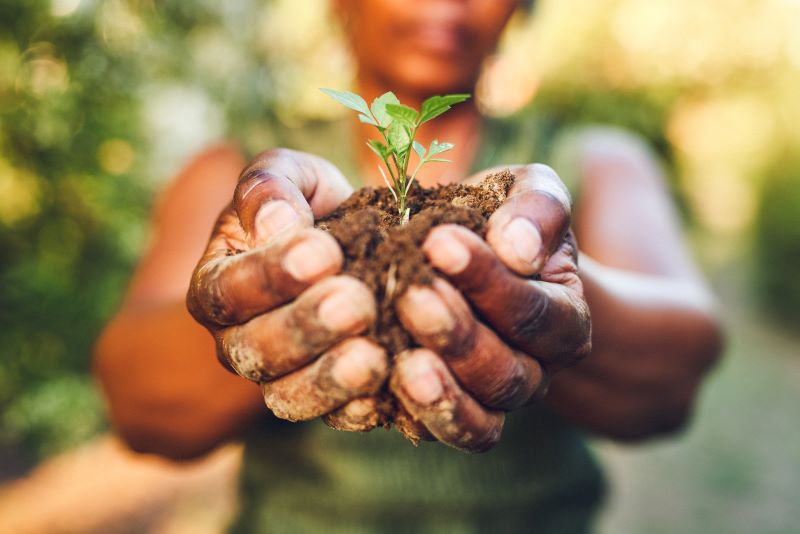Learn more about this rapidly growing trend in landscaping that is not only dedicated to cultivating an aesthetically pleasing design, but also a great deal of home-grown nutrition for its caregivers.
Edible landscaping: What is it?
When many people think of gardens, they tend to think of a very specific part of their landscape. Maybe it’s an area of your yard that is hidden at the back of your property, or it’s specific to one or more raised garden beds, or even grown entirely in containers.
What’s distinctive about edible landscaping is that it is a gardening technique that seeks to fully integrate edible plants into the landscape itself, so that your yard doesn’t have a garden; your yard is a garden.
While popularity in home gardening has already been on the rise in the last several years, 2020 saw an incredible increase in the popularity of people growing their own fresh fruits, vegetables, and flowers. Similarly, this interest in edible landscaping has also been increasing.
For about a decade now, homeowners in the United States have been exploring more ways in which they can spend more quality time in their yards, use resources more efficiently, and increase the biodiversity of their landscapes.
Things to consider about edible landscapes
Edible landscapes require thoughtful preparation
Now, when we say preparation, we’re referring to the transformation of your traditional lawn or landscape into what will become your edible landscape. This means tearing out the grass of your existing landscape (or whatever material currently occupies your yard) and preparing the space with the appropriate soil and other materials that will best help your garden flourish.
What do you really want out of your landscape?
Another thing to prepare — and this is probably the most important part — is what you’re hoping to get out of this new landscape design. The more successful and sustainable designs we’ve seen incorporate a combination of edible plants, flowers, and fruit trees.
This means that you have to be especially mindful of creating combinations of annual and perennial plants. One reason for this is ensuring that you’re giving everything the space it needs, especially things like fruit trees, which will no doubt grow much bigger than they are when you first plant them. Another reason is that it helps you maintain a level of aesthetic interest throughout your growing seasons.
With the right maintenance, you can have beautiful, edible plants all year long
We’re lucky enough here in the Pacific Northwest that we can grow edible plants even throughout most winters, and having a carefully constructed roadmap that includes the plants, flowers, fruits, and vegetables you want to grow, as well as their growing cycles, sun and watering needs, and other important factors will help you be more successful in maintaining a beautiful and edible garden.
Remember that many plants bearing fruits or vegetables will need as many of eight hours of direct sunlight, so ensure that you can give your plants all the natural resources they truly need before planting.
Do you have enough time in your life for an edible landscape garden?
While an edible landscape is a beautiful, functional alternative to a more traditional lawn and style of gardening, it does require a great deal of a specific type of maintenance.
Sure, a traditional lawn requires mowing, edging, fertilization, and all the other commonly known tasks in order to keep it lush, green, and healthy. Paying particular attention to soil health, clearing the garden of weeds, careful use of fertilizers, appropriate watering, and pest control are all things that need to be done — and need to be done at the right time in the right way.
It’s not necessarily a more delicate process, but it’s a different type of process than a lawn with garden beds or pots. Done in the right way, and you not only have a unique, gorgeous looking yard that you’ll love spending time in, but you’ll also be able to enjoy the literal fruits of your labor.
Some of our favorite edible landscape plants
- Apple, cherry, fig, plum, and pear trees — Though they, of course, vary in height as well as yield, these fruit trees will typically grow between ten and twenty feet tall, with gorgeous, colorful blossoms in spring and delicious fruit in the summer and fall months
- Blueberry, huckleberry, and rhubarb — These shrubs are a more medium height for your landscape, measuring around three to ten feet, depending on plant. All three of these plants are relatively easy to grow and maintain, and all will give you abundant fruit in the summer. Remember that despite their big, beautiful leaves, only the stalks of rhubarb plants should be eaten. Their leaves can be poisonous.
- Strawberry, kale, chard, and lettuce — Smaller in height, but enormous in personality, these plants add a variety of color and texture to your yard, as well as some much-needed nutrients to your diet. Certain varieties of kale and chard will grow well into the winter, ensuring your edible landscape can maintain its functionality even in the cooler months.
Is an edible landscape right for you?
Edible landscapes are a very different approach to a yard than your more traditional lawns, but with the right mindset, plan, and commitment, we believe that they can fit in nicely with just about any home’s style.
We believe that this style of landscape design can fit in well with all styles of water features, outdoor living or work spaces — pretty much every outdoor feature you can imagine. That’s the beauty of having a landscape design partner who is committed to bringing your vision to life, because we can make big ideas turn into spaces where you can make cherished memories.
Ready to learn more about how you can make your landscape as unique as you are? Contact Greenhaven Landscapes today. We can’t wait to make your landscape dreams come true!

